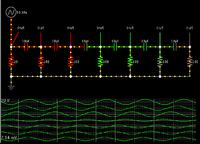krazyfencer
Junior Member level 2

- Joined
- Aug 5, 2013
- Messages
- 23
- Helped
- 0
- Reputation
- 0
- Reaction score
- 0
- Trophy points
- 1
- Location
- East Coast, USA
- Activity points
- 266
Hello,
Hopefully this isn't duplicating any other thread, I've looked but have not found an answer that I understand. I think I understand how a capacitor stores charge in an electric field, and I believe I understand why there is a phase shift in the output of the capacitor with respect to the input. What I am confused about is how and why the capactive reactance and resistance are used to calculate the phase shift.
1) can someone explain the idea behind arctan(theta) = Xc / R? I'm not looking for a mathematical proof, just a simple explanation of how the reactance and resistance defines the shift in phase. Does it have to do with the charging/discharging rate of the capacitor and estimating how 'full' the capacitor is?
2) which resistance is used for calculating the above formula? The total resistance of the entire circuit? The resistance of just the next resistor in series with the capacitor? So if you have two RC elements like , what is the R used to calculate the theta of C1? 1 / (1/R1 + 1/R2) ? Just R1? Does the reactance of C2 contribute to the overall resistance used to calculate the theta of C1?
, what is the R used to calculate the theta of C1? 1 / (1/R1 + 1/R2) ? Just R1? Does the reactance of C2 contribute to the overall resistance used to calculate the theta of C1?
Thanks!
Hopefully this isn't duplicating any other thread, I've looked but have not found an answer that I understand. I think I understand how a capacitor stores charge in an electric field, and I believe I understand why there is a phase shift in the output of the capacitor with respect to the input. What I am confused about is how and why the capactive reactance and resistance are used to calculate the phase shift.
1) can someone explain the idea behind arctan(theta) = Xc / R? I'm not looking for a mathematical proof, just a simple explanation of how the reactance and resistance defines the shift in phase. Does it have to do with the charging/discharging rate of the capacitor and estimating how 'full' the capacitor is?
2) which resistance is used for calculating the above formula? The total resistance of the entire circuit? The resistance of just the next resistor in series with the capacitor? So if you have two RC elements like
 , what is the R used to calculate the theta of C1? 1 / (1/R1 + 1/R2) ? Just R1? Does the reactance of C2 contribute to the overall resistance used to calculate the theta of C1?
, what is the R used to calculate the theta of C1? 1 / (1/R1 + 1/R2) ? Just R1? Does the reactance of C2 contribute to the overall resistance used to calculate the theta of C1?Thanks!



